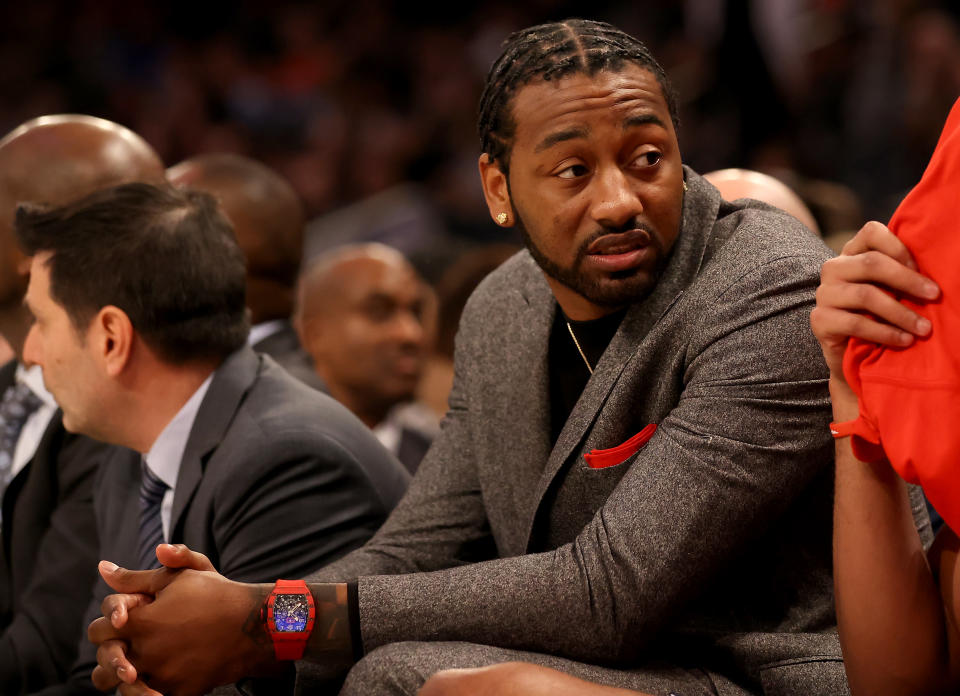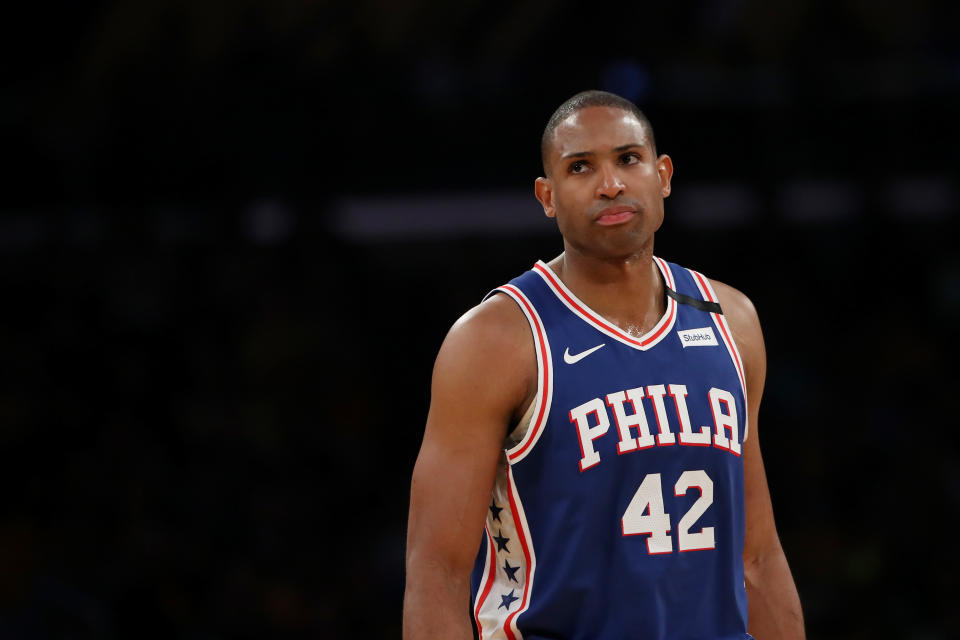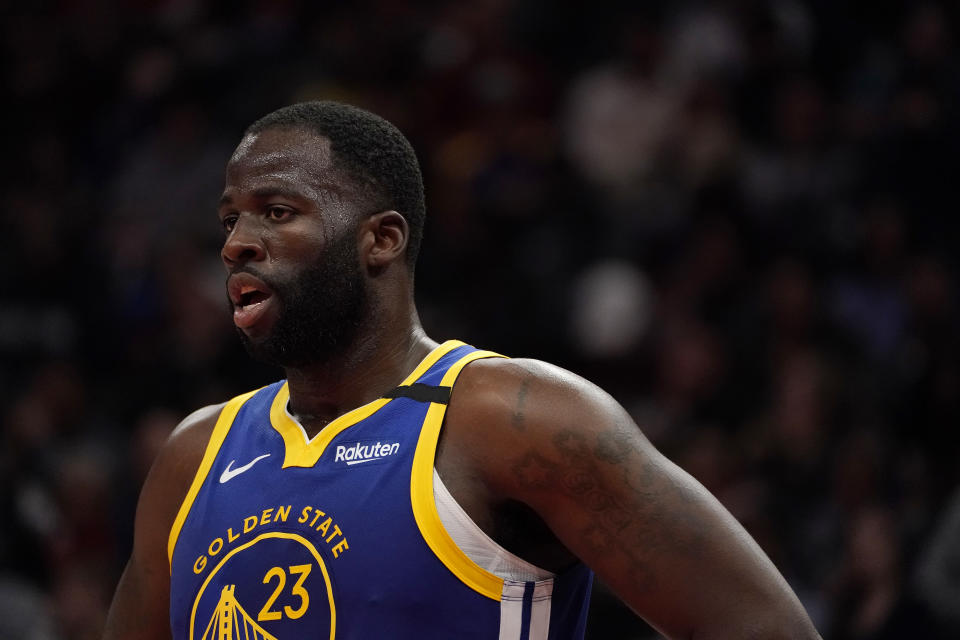John Wall, Russell Westbrook and the 12 hardest NBA contracts to trade
The NBA is inching towards lifting its moratorium on transactions. There are always financial implications to every move, but perhaps never more so than this offseason, when few teams have salary cap space and all of them are facing an uncertain economy entering a second season disrupted by the coronavirus pandemic.
Money could motivate more decisions than ever before, and there are a dozen unwanted long-term contracts that will severely impact the trade market. They will either be the driving forces behind deals or the reason many do not get done. These are the NBA’s most burdensome three- and four-year contracts.
We narrowed our window for bad deals to at least three years, because players like 35-year-old Chris Paul and oft-injured Blake Griffin — both owed north of $75 million over the next two seasons — are no longer the cumbersome contracts they once were. Either may be a more attractive asset than any of the players on this list of worst long-term deals in the league, if only because the risk and reward have balanced a bit. Even if they do not reach the All-NBA level for which they are being compensated, they are only one season from becoming expiring contracts — often cap-clearing assets unto themselves, regardless of production.
But these 12 deals are the kind that can cripple team-building efforts. They represent a large portion of team salary that does not live up to its value. In order to reallocate the funds, it can cost additional assets, unless one bad deal is traded for another. We are a year removed from the Houston Rockets adding two first-round picks and a pair of pick swaps to unload Paul’s contract. There is hope, then, that these deals will eventually become neutral or even positive, but for now they are roadblocks to roster improvement.
Fewer front offices make the sort of cap-strapping contract offers that ruled free agencies of yesteryear. Fans can only hope big-money deals for the likes of Gorgui Dieng and James Johnson are a thing of the past. (They were traded for each other in February and will both finally come off the books at season’s end.)
But circumstances still force general managers to make moves they know they should not. Some deals are known to be bad before they are ever signed. Superstars can strong-arm GMs into overpaying free agents. Teams have given max deals to non-max players for fear of losing them without viable replacements. Restricted free agents can land outsized offers meant to outbid incumbent teams or force them to match.
Whatever the reason, bad contracts will always impede roster optimization, forcing teams to pick between swallowing sunk cost or incentivizing someone else to carry the burden. These are the worst of those deals.

1. John Wall, Washington Wizards (3 years, $132,932,520)
2020-21: $41,254,920
2021-22: $44,310,840
2022-23: $47,366,760 (player option)
Wall almost belongs in a tier of his own. He signed a super-max extension that took effect the year after he last appeared in an NBA game in December 2018. He is a 30-year-old with a history of knee problems, also returning from a career-threatening Achilles injury, slated to make almost $50 million in the 2022-23 season.
Even if Wall were to reach his pre-injury level as the All-Star point guard of an Eastern Conference also-ran, he would still be overpaid. Wall will earn more than LeBron James this season. The only shot the Wizards have of unloading his deal is tying it to All-Star guard Bradley Beal or an inordinate number of first-round picks, and what little value either trade would return may not outweigh the cost of keeping Wall rostered.
Washington has been stuck building a roster with almost 40 percent of the salary cap on the sideline. Even if Wall does play, the best the Wizards can hope for is being just good enough to pick from the middle of the draft, and the ensuing cycle of that mediocrity will eventually lead Beal to seek a trade. There is no path to contention in Washington that does not involve planning for 2023, when Wall’s $133 million is paid in full.
2. Tobias Harris, Philadelphia 76ers (4 years, $147,258,000)
2020-21: $34,358,850
2021-22: $35,995,950
2022-23: $37,633,050
2023-24: $39,270,150
Harris is a good player. He is just not franchise money good. That Sixers GM Elton Brand thought it prudent to offer Harris the full five-year max, only to short Jimmy Butler, is beyond sensical and one reason the team hired Daryl Morey to make those decisions instead. Harris is due more money over the next four years than anybody but Klay Thompson, and who wants to pay that for a player who only borders on All-Star-caliber?
Nobody will offer anything close to equal value in return, especially if Harris does not come with a cache of picks, and the Sixers already spent two first-rounders to acquire him. Philadelphia is faced with holding him as their highest-paid player or getting worse, a major hurdle for Morey’s efforts to retool around Joel Embiid and Ben Simmons. The failure to nail a max-salaried third star may cost Morey one of the team’s top two.
3. Russell Westbrook, Houston Rockets (3 years, $132,633,438)
2020-21: $41,358,814
2021-22: $44,211,146
2022-23: $47,063,478 (player option)
Of course, Morey left Houston after trading Paul, two first-round picks and a pair of pick swaps for an additional $47 million season from Westbrook in 2022-23. He will be 33 years old then, six years removed from his MVP season. Westbrook is still capable of playing at an All-NBA level, albeit one that left James Harden short of where he was with Paul and no higher than he ever had been with Eric Gordon as a co-star.
Is there a market for Westbrook, who even in his most efficient season in years was not an advanced stats darling? His relentlessness is the hallmark of his game, and his contract will depreciate along with that skill.
4. Andrew Wiggins, Golden State Warriors (3 years, $94,738,170)
2020-21: $29,542,010
2021-22: $31,579,390
2022-23: $33,616,770
Wiggins became a bad contract the moment he put pen to paper on his max extension. Before the former No. 1 overall pick even turned 26 years old, the Wolves had to attach a likely 2021 lottery pick to swap him for another overpaid underachiever. Now, the Warriors will hope their own No. 2 overall pick and the first-rounder they acquired from Minnesota will be enough to turn Wiggins’ salary into a player of some value.

5. Al Horford, Philadelphia 76ers (3 years, $81,000,000)
2020-21: $27,500,000
2021-22: $27,000,000
2022-23: $26,500,000 ($14.5 million guaranteed)
Brand not only paid Harris, he gave the bulk of what he offered Butler to Horford, a former All-Star who effectively finished his first season of a four-year, nine-figure deal as a backup center to Embiid. Horford might still be able to help a team, just not this one, and at what cost to the Sixers? The saving grace of his deal is that “only” $14.5 million of his $26.5 million salary is guaranteed in 2022-23, when he will turn 37.
6. Kevin Love, Cleveland Cavaliers (3 years, $91,459,342)
2020-21: $31,258,256
2021-22: $31,258,256
2022-23: $28,942,830
The Cavs have seemingly been trying to extract value from Love’s contract almost as soon as he signed an extension in 2018, only to whiff on deals that would not also require them to attach assets. Love can still log All-Star numbers, including above-average shooting for a rebounding big man, so his demonstrated lack of trade interest should be fair warning for teams trying to unload players who carry less value for more salary.
7. Eric Gordon, Houston Rockets (4 years, $75,574,356)
2020-21: $16,869,276
2021-22: $18,218,818
2022-23: $19,568,360
2023-24: $20,917,902 (non-guaranteed)
In the year since Gordon signed his long-term extension, his deal with the Rockets has gone from questionable to cumbersome. Houston felt compelled to pay Gordon, for fear his talent could not be replaced on a team that needs quality complementary players around Harden to contend. But the injury issues that plagued Gordon’s early career returned before he began collecting his extension, and Morey’s successor is now tasked with upgrading a roster that features two highly overpaid players around Harden.
8. Buddy Hield, Sacramento Kings (4 years, $86,000,000)
2020-21: $24,431,818 (estimated via Spotrac)
2021-22: $22,477,273
2022-23: $20,522,727
2023-24: $18,568,182
Hield bristled at the extension he eventually signed and remains disgruntled a year later. Approaching his 28th birthday, he holds some value as an elite shooter in a league that covets them, even if his defense is a detriment. But red flags will follow a player who was still unsatisfied in his role as his team’s leader in shot attempts. Maybe he would be more amenable to a diminished role (and a better fit) on a contender, but how eager are teams to commit a long-term high salary for a guy who lost his starting job on a sub-.500 team?

9. Draymond Green, Golden State Warriors (4 years, $99,666,362)
2020-21: $22,246,956
2021-22: $24,026,712
2022-23: $25,806,469
2023-24: $27,586,225 (player option)
Green is worth more to the Warriors than he is anybody else, still capable of anchoring small-ball lineups defensively and facilitating a motion offense that also features Thompson and Stephen Curry. He will also turn 31 years old next season, five years removed and a full step slower from when he was the third-best player on a 73-win team. We saw what Green was absent the Splash Brothers, and it was not worth what he will earn in the first year of his extension, let alone the $27.6 million he is owed in the 2023-24 season.
10. Harrison Barnes, Sacramento Kings (3 years, $60,852,273)
2020-21: $22,215,909
2021-22: $20,284,091
2022-23: $18,352,273
Eight of the 10 worst long-term contracts belong to four teams. It is no coincidence that three of them revamped their front offices this offseason and the other owned the highest draft lottery odds. The Mavericks overpaid Barnes to sign him away from the Warriors in 2016, salary dumped him on Sacramento three years later, and the Kings doubled down to pay a glorified role player more than $20 million annually through 2023. Barnes will finish this contract with $188 million in career earnings before his 31st birthday.
11. Khris Middleton, Milwaukee Bucks (4 years, $146,896,552)
2020-21: $33,051,724
2021-22: $35,500,000
2022-23: $37,948,276
2023-24: $40,396,552 (player option)
The Bucks had little choice but to pay Middleton his money, because failing to do so risked alienating Giannis Antetokounmpo ahead of his 2021 free agency. (It is a wonder they did not apply the same logic to Malcolm Brogdon.) A year later, Middleton’s contract may be reason for Antetokounmpo to look elsewhere.
Middleton is an All-Star and the second-best player on a team that was on pace to win 70 games for much of last season. He has also proven not to be the co-star who can help Antetokounmpo compete against other star-laden teams in the playoffs. Should Antetokounmpo re-sign with the Bucks, he will be tying his prime years to Middleton, a very good but not great player who is being paid like a superstar partner. They had to pay him, but as soon as they did, they committed to getting less than max value for a max deal.
12. D’Angelo Russell, Minnesota Timberwolves (3 years, $90,040,500)
2020-21: $28,649,250
2021-22: $30,013,500
2022-23: $31,377,750
Russell is a prime example that it can be better to overpay a player than to never pay him at all. The Warriors risked losing Kevin Durant for nothing in 2019 free agency and opted to negotiate a sign-and-trade deal with the Nets that salvaged Russell at a salary high enough to facilitate the transaction. In the process, they robbed the Wolves of signing a player they coveted, keeping that interest in mind. Russell’s contract was not quite so bad as the one Minnesota owed to Wiggins, so Golden State squeezed a high-end draft pick out of a swap, banking on the hope that they can sweeten that same package for substantial value.
Eventually, Wiggins and Russell could become value-neutral contracts, and as we learned from the Paul-Westbrook trade, it is far better to be the team collecting draft assets when swapping bad contracts. Keep that in mind if and when players on this list start ending up in the same trade rumors in the coming weeks.
– – – – – – –
Ben Rohrbach is a staff writer for Yahoo Sports. Have a tip? Email him at rohrbach_ben@yahoo.com or follow him on Twitter! Follow @brohrbach
More from Yahoo Sports:


